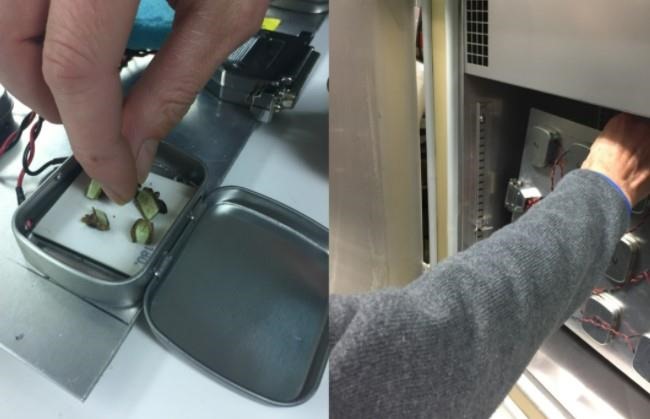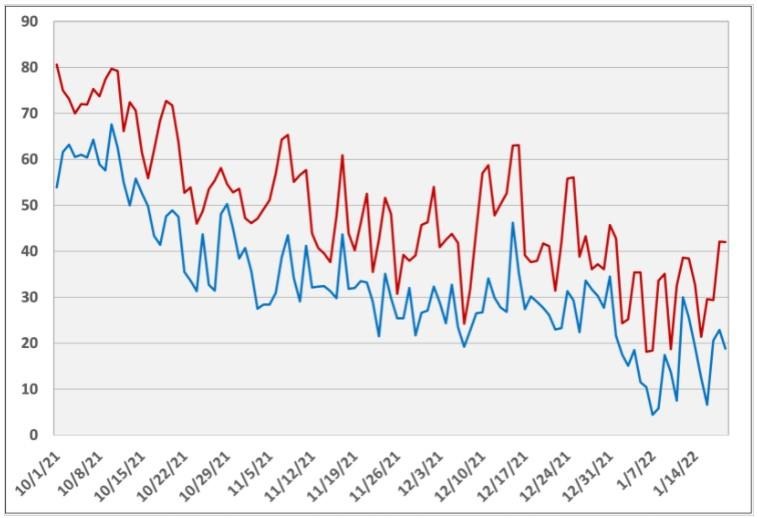By William Shane and Michael Reinke
Grape growers around Michigan watch the snow, and the thermometer, fall each winter and wonder how their grapes are faring. Have the buds hardened off to survive the long, cold weather? Are they acclimated enough to survive the deep freeze coming tonight? Do I have to adjust my early spring pruning to compensate for any winter damage that did occur? How much do I compensate?
An ongoing research project at the Michigan State University Southwest Michigan Research and Extension Center (SWMREC) is attempting to help answer some of those questions.
The southwest Michigan grape bud winter hardiness research project is a collaboration between Michigan State University Extension and the Michigan Grape Society and is funded in part by a Michigan Department of Agriculture and Rural Development (MDARD) USDA Specialty Crop Grant. This project, under the direction of Bill Shane and Mike Reinke and technical help from Jennifer Schoonmaker, is in its second year. The project has 10 southwest Michigan grower cooperators providing samples of 11 grape varieties.
The traditional method for testing how buds tolerate cold temperatures is to collect vines, subject them to a series of cold temperatures, then cut the fruit buds to see what temperatures killed them. This new project uses new technology that is quicker, less labor intense, and more precise.
The southwest Michigan grape bud hardiness project uses an improved method called differential thermal analysis (DTA). Grape buds are placed in a programmable freezer where the temperature is slowly decreased over 14 hours, much like a winter freeze event. When buds freeze, the water in the plant cells turn to ice, which releases a small amount of heat. The computerized DTA system records the temperature and time of these heat spikes, one for each bud. If you analyze enough buds, you can determine the lethal temperature (LT) where 10%, 50% or 90% of the buds are killed. These are called the LT10, LT50 and LT90 temperatures, respectively.
Much of the winter of 2020-2021 was spent learning how to accurately use the DTA method to collect the LTs for various grape varieties. This winter the researchers have been collecting weekly bud samples from 11 grape varieties to assess the hardiness of grapes in southwest Michigan. Now that the region is, hopefully, halfway through the coldest parts of the winter, the researchers share here recent results to help growers assess crop potential, what pruning needs to be done in the next couple months, and what future weather extremes could cause problems.
 This project uses differential thermal analysis to identify the temperatures below which grapevine damage can occur. Grape buds are placed in small chambers. The chambers are frozen under carefully controlled conditions and time and temperature of bud death can be precisely determined for each grape bud used in the study. Photo by Bill Shane, MSU Extension.
This project uses differential thermal analysis to identify the temperatures below which grapevine damage can occur. Grape buds are placed in small chambers. The chambers are frozen under carefully controlled conditions and time and temperature of bud death can be precisely determined for each grape bud used in the study. Photo by Bill Shane, MSU Extension.Weather
The fall of 2021 was warm and humid, causing opportunities for late disease infection events. This stressed vines that were not well protected. This caused some premature defoliation in some vineyards. Vines that stayed healthy went into the winter in good shape. So far, the winter of 2021-2022 has been mild with temperatures near average with no major cold events. The lowest temperatures so far occurred on the morning of Jan. 8, 2022, when much of the region saw lows near 2-5 degrees Fahrenheit, well above the temperatures predicted by the DTE data that could cause damage.
Precipitation amounts have also been near average, but most of it has come as rain. Snow amounts this year have been below average, which can be a concern for those growers that rely on snow to protect grapevine trunks.
The long lead forecasts for southwest Michigan are for average temperature and above average precipitation for February and above average temperatures and precipitation for March and April.
 The daily high (red) and low (blue) temperatures at the Southwest Michigan Research and Extension Center have been near average for much of the fall and winter so far.
The daily high (red) and low (blue) temperatures at the Southwest Michigan Research and Extension Center have been near average for much of the fall and winter so far.Grape hardiness
The average temperatures for the first half of the winter have given the grapes the opportunity to safely acclimate. No cold damage has been reported or seen at this time. Temperatures have been well above the grape bud LT50 numbers, the point of significant damage, even for the most sensitive vinifera varieties. The most current LT50 temperatures for European vinifera grapes are mostly in the range of -5 to -10 F. Juice grapes and hybrid wine grape LT50s are -10 to -20 F.
More detailed information by variety is presented below. So far, these numbers track closely with the LT50s measured in 2020/2021, the first year of the project.
Cabernet franc LT50 (F) |
|---|
Date | Arrowhead | Domaine Berrien | SWMREC |
|---|
23-Nov-21 | -- | -- | -5.5 |
2-Dec-21 | -1.1 | -0.1 | -3.4 |
10-Dec-21 | -5.9 | -4.1 | 2.4 |
16-Dec-21 | -5.9 | 1.8 | -8.8 |
21-Dec-21 | -4.6 | -7.0 | -9.9 |
28-Dec-21 | -5.0 | -3.5 | -5.6 |
4-Jan-22 | -6.6 | -- | -9.9 |
11-Jan-22 | -4.5 | -4.1 | -6.4 |
Cabernet sauvignon LT50 (F) |
|---|
Date | Arrowhead | Domaine Berrien | Lemon Creek | Mountain Road |
|---|
2-Dec-21 | -1.0 | -3.3 | 3.9 | -0.5 |
10-Dec-21 | -5.3 | -4.6 | -1.2 | -4.7 |
16-Dec-21 | -6.0 | -5.0 | -5.5 | -4.6 |
21-Dec-21 | -4.9 | -6.4 | 1.5 | -5.2 |
28-Dec-21 | -6.3 | -3.3 | -7.4 | -4.0 |
4-Jan-22 | 5.9 | -- | -5.5 | -5.9 |
11-Jan-22 | 0.9 | -4.4 | -5.2 | -- |
Merlot LT50 (F) |
|---|
Date | 12 Corners | Lemon Creek | SWMREC |
|---|
23-Nov-21 | -- | -1.3 | 1.6 |
2-Dec-21 | -- | -0.2 | -3.7 |
10-Dec-21 | -5.1 | -5.0 | -5.6 |
16-Dec-21 | -5.3 | -1.5 | -7.9 |
23-Dec-21 | -7.9 | -6.7 | -7.6 |
28-Dec-21 | -7.3 | -3.5 | -5.8 |
6-Jan-22 | -9.3 | -6.6 | -8.6 |
11-Jan-22 | -8.7 | -1.8 | -4.2 |
Sauvignon blanc LT50 (F) |
|---|
Date | Domaine Berrien | Lemon Creek | Mountain Road |
|---|
23-Nov-21 | -- | 2 | -- |
2-Dec-21 | 0.6 | 1 | -1.1 |
10-Dec-21 | -1.6 | -3.3 | -3.3 |
16-Dec-21 | -- | -4.7 | -2.6 |
23-Dec-21 | -5.0 | -4.7 | -4.3 |
30-Dec-21 | -2.7 | -3.2 | -3.7 |
6-Jan-22 | -- | -6.4 | -5.1 |
13-Jan-22 | -0.6 | 1.1 | -- |
Pinot gris LT50 (F) |
|---|
Date | 12 Corners | Arrowhead | Domaine Berrien | Outcross |
|---|
2-Dec-21 | -3.5 | -2.9 | -6.4 | -4.7 |
10-Dec-21 | -5.0 | -7.7 | -5.6 | -6.7 |
16-Dec-21 | -7.5 | -5.5 | -6.7 | -7.5 |
23-Dec-21 | -9.0 | -4.5 | -8.7 | -8.9 |
28-Dec-21 | -7.6 | -7.9 | -4.6 | -7.0 |
6-Jan-22 | -11.6 | -8.9 | -- | -8.9 |
11-Jan-22 | -9.4 | -6.8 | -7.3 | -7.3 |
Pinot noir LT50 (F) |
|---|
Date | Lemon Creek | Mountain Road | Willie’s of the Valley |
|---|
23-Nov-21 | -3.0 | -- | -- |
2-Dec-21 | -6.0 | -3.4 | -4.8 |
10-Dec-21 | -6.4 | -8.6 | -7.8 |
16-Dec-21 | -5.0 | -6.8 | -6.5 |
23-Dec-21 | -8.9 | -6.3 | -7.2 |
30-Dec-21 | -5.3 | -6.4 | -5.5 |
6-Jan-22 | -10.4 | -8.6 | -9.2 |
13-Jan-22 | -7.7 | | -8.5 |
Traminette LT50 (F) |
|---|
Date | Arrowhead | Lemon Creek | SWMREC |
|---|
23-Nov-21 | -- | -0.9 | -7.5 |
2-Dec-21 | -7.3 | -7.1 | -11.8 |
10-Dec-21 | -10.8 | -8.2 | -13.1 |
16-Dec-21 | -11.5 | -6.4 | -11.0 |
21-Dec-21 | -9.0 | -10.3 | -16.8 |
28-Dec-21 | -12.0 | -8.4 | -9.0 |
4-Jan-22 | -5.9 | -13.0 | -15.2 |
11-Jan-22 | -12.2 | -6.6 | -9.4 |
Marquette LT50 (F) |
|---|
Date | Hunt’s Hillside | SWMREC |
|---|
23-Nov-21 | -- | -14.2 |
30-Nov-21 | -9.8 | -14.3 |
9-Dec-21 | -11.7 | -12.8 |
14-Dec-21 | -13.1 | -13.7 |
21-Dec-21 | -9.0 | -18.6 |
28-Dec-21 | -12.1 | |
4-Jan-22 | -14.1 | -16.5 |
11-Jan-22 | -17.0 | -9.1 |
Marechal Foch LT50 (F) |
|---|
Date | 12 Corners | Arrowhead | Oxley | Hunt’s Hillside |
|---|
2-Dec-21 | -7.5 | -7.3 | -10.2 | -10.4 |
10-Dec-21 | -12.5 | -14.5 | -13.9 | -13.3 |
16-Dec-21 | -10.7 | -12.1 | -12.2 | -12.0 |
23-Dec-21 | -14.8 | -12.8 | -13.6 | -12.2 |
28-Dec-21 | -15.3 | -13.6 | -10.6 | -13.5 |
6-Jan-22 | -18.0 | -18.5 | -14.6 | -13.6 |
11-Jan-22 | -14.9 | -16.5 | -17.4 | -16.9 |
Concord LT50 (F) |
|---|
Date | Lemon Creek | SWMREC | Oxley |
|---|
23-Nov-21 | -10.7 | -7.8 | -- |
2-Dec-21 | -8.0 | -10.1 | -8.8 |
10-Dec-21 | -11.5 | -15.1 | -13.6 |
16-Dec-21 | -11.6 | -12.7 | -12.8 |
23-Dec-21 | -11.8 | -18.3 | -12.9 |
30-Dec-21 | -11.1 | -16.4 | -10.7 |
6-Jan-22 | -15.1 | -19.0 | -16.6 |
13-Jan-22 | -9.3 | -11.7 | -15.1 |
Niagara LT50 (F) |
|---|
Date | Arrowhead | SWMREC | Oxley |
|---|
23-Dec-21 | -- | -8.8 | -- |
2-Dec-21 | -2.5 | -9.3 | -10.1 |
10-Dec-21 | -7.3 | -10.7 | -12.3 |
16-Dec-21 | -5.2 | -9.4 | -9.9 |
21-Dec-21 | -5.4 | -13.7 | -11.1 |
28-Dec-21 | -8.9 | -10.5 | -11.0 |
4-Jan-22 | -11.6 | -15.8 | -16.5 |
11-Jan-22 | -10.6 | -8.8 | -16.8 |
The research team from Michigan State University Extension, with the help of cooperating growers and the Michigan Grape Society, will continue this project for the remainder of the 2021-2022 winter. The MSU team will continue updating the grape growing community about current grape bud hardiness conditions through presentations at the Southwest Michigan Horticulture Days on Feb. 2-3, 2022, and a southwest region grape preseason kickoff meeting, date still to be determined.
Source : msu.edu